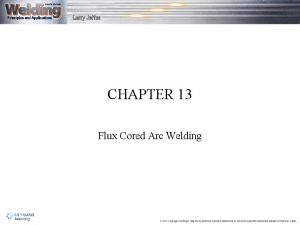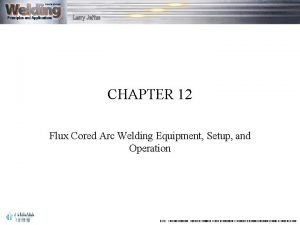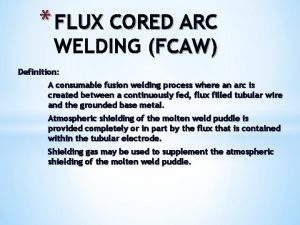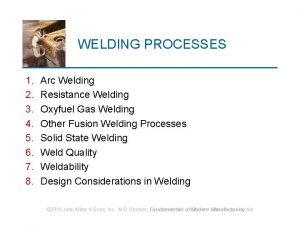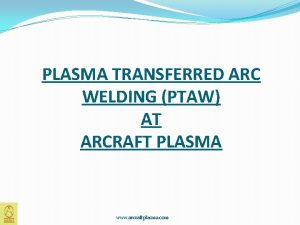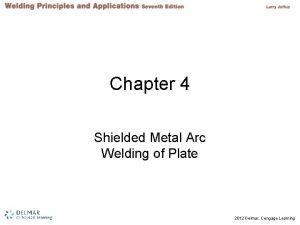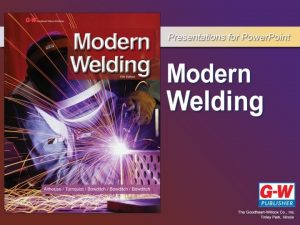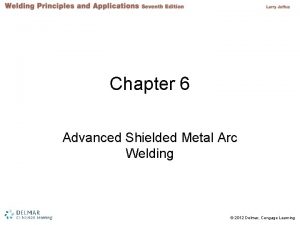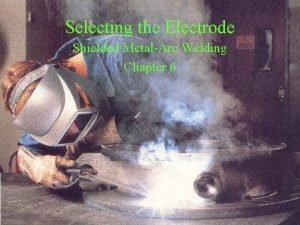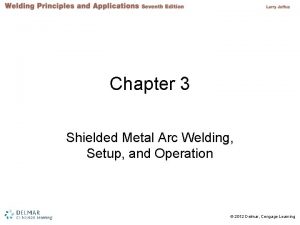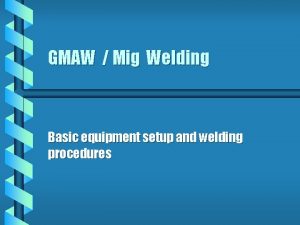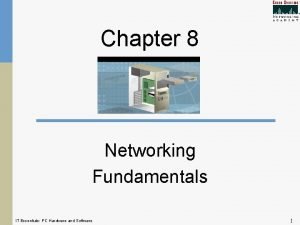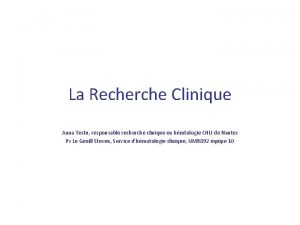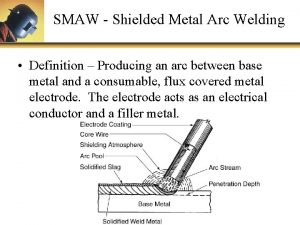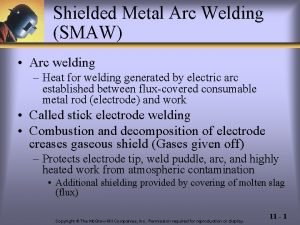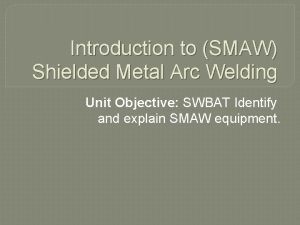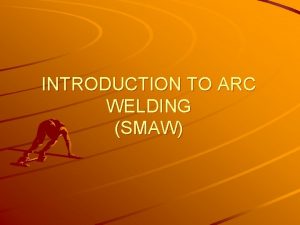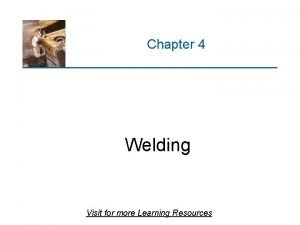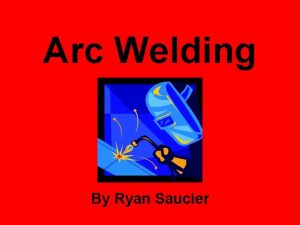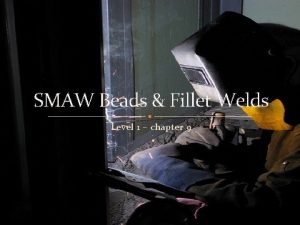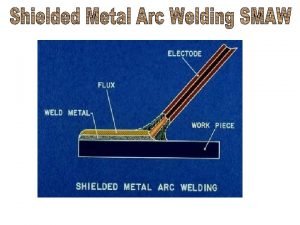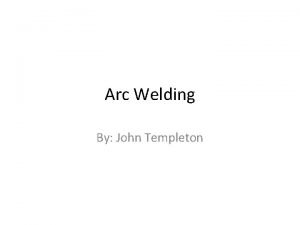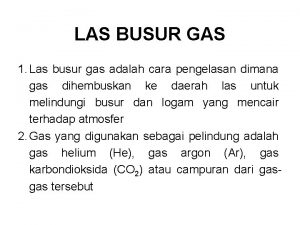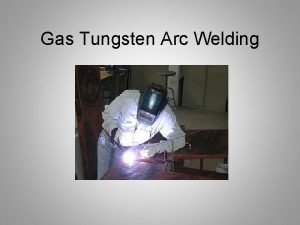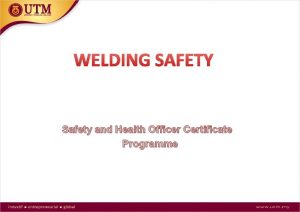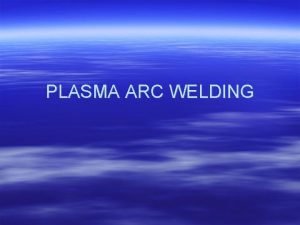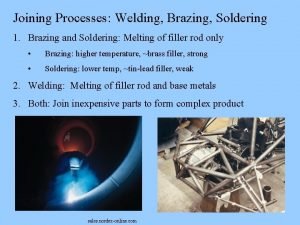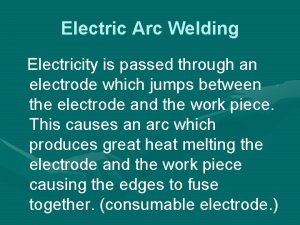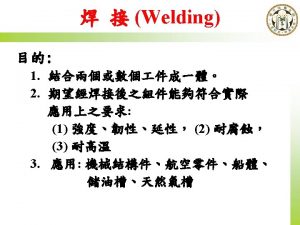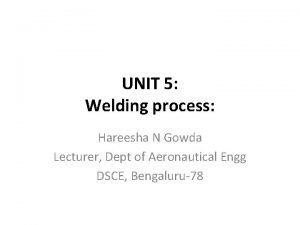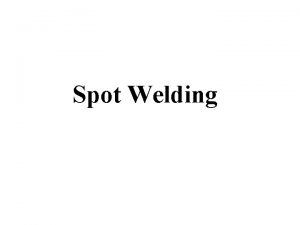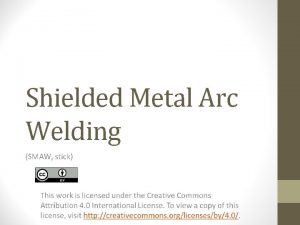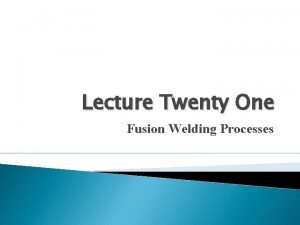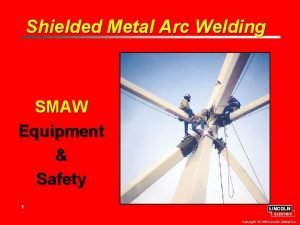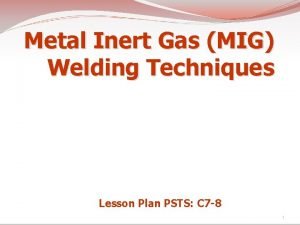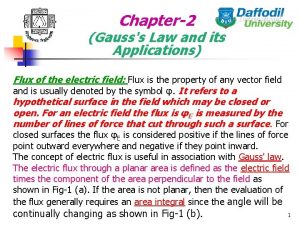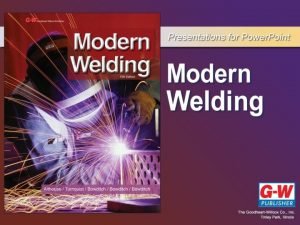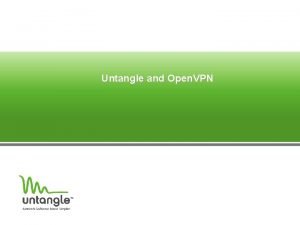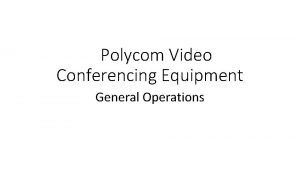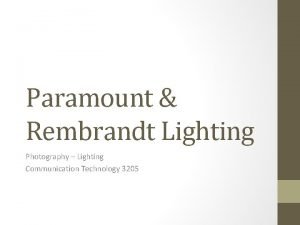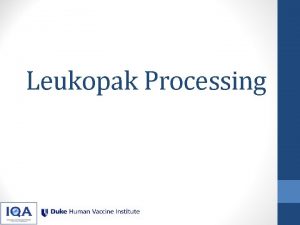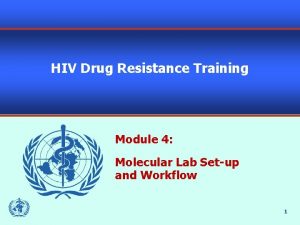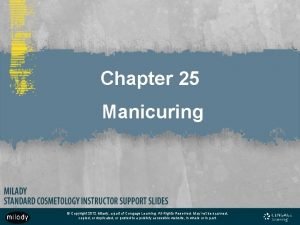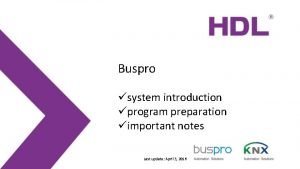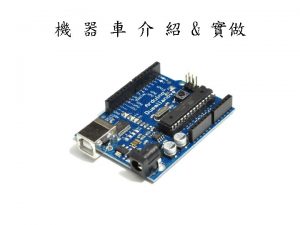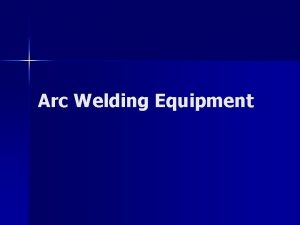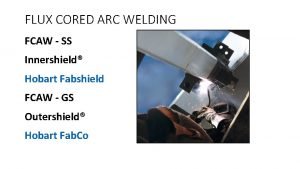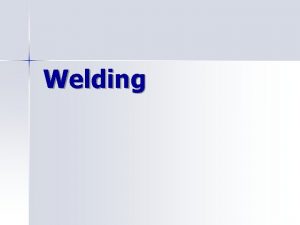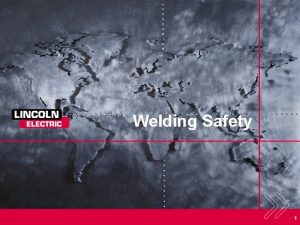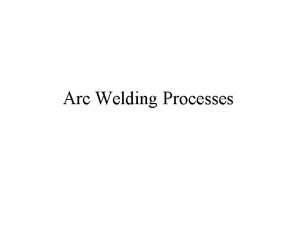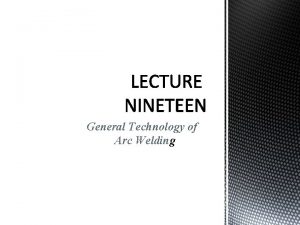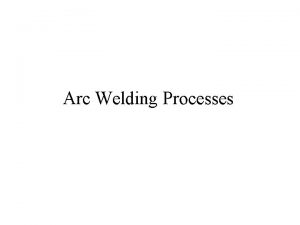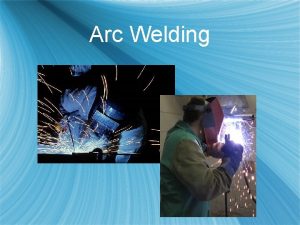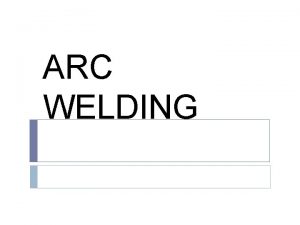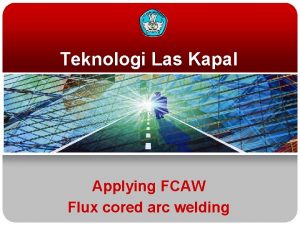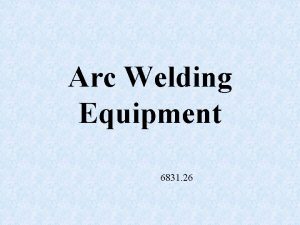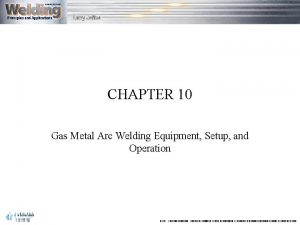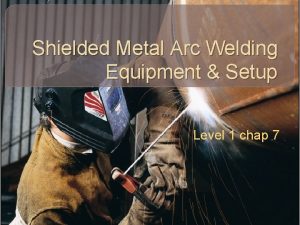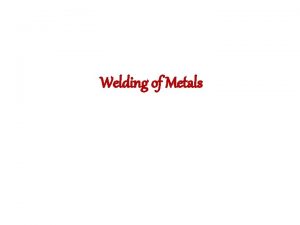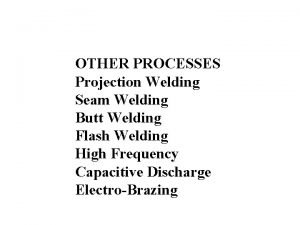CHAPTER 12 Flux Cored Arc Welding Equipment Setup






































































- Slides: 70

CHAPTER 12 Flux Cored Arc Welding Equipment, Setup, and Operation

OBJECTIVES • After completing this chapter, the student should be able to – – explain the FCA welding process. describe what equipment is needed for FCA welding. list the advantages of FCA welding, and explain its limitations. tell how electrodes are manufactured and explain the purpose of the electrode cast and helix. – discuss what flux can provide to the weld and how fluxes are classified. – explain what each of the digits in a standard FCAW electrode identification number mean.

OBJECTIVES (cont. ) – describe the proper care and handling of FCAW electrodes. – list the common shielding gases used, and explain their benefits. – explain how changing the welding gun angle affects the weld produced. – identify the methods of metal transfer and describe each. – explain the effect electrode extension has on FCA welding. – tell what can cause weld porosity and how it can be prevented.

KEY TERMS • • • • air-cooled gun carbon coils deoxidizers dual shield flux cored arc welding (FCAW) forehand lime-based flux rutile-based flux self-shielding slag smoke extraction nozzle spools water-cooled gun

INTRODUCTION • Flux cored arc welding (FCAW) is a fusion welding process in which weld heating is produced from an arc between the work and a continuously fed filler metal electrode. • Although the process was introduced in the 1950 s, it represented less than 5% of the total amount of welding done in 1965. • In 2005, it passed the 50% mark for filler metal usage. • Its popularity continues to rise because of a number of factors. • Improvements in the fluxes, availability of smaller diameter electrodes, reliability of the equipment, better electrode feed systems, and improved guns have all led to the increased usage.

INTRODUCTION • Self-Shielded Flux Cored Arc Welding (FCAW-S) • Dual-Shielded Flux Cored Arc Welding (FCAW-S)

PRINCIPLES OF OPERATION • FCA welding is similar to GMA welding in a number of ways, Figure 12 -3. • Both processes use a constant-potential (CP) or constantvoltage (CV) power supply.

FLUX CORE • The flux core additives that serve as deoxidizers, gas formers, and slag formers either protect the molten weld pool or help to remove impurities from the base metal. • Deoxidizers may convert small amounts of surface oxides like mill scale back into pure metal. • They work much like the elements used to refine iron ore into steel.

GAS FORMERS • Some elements in the flux that rapidly expand, called gas formers, push the surrounding air away from the molten weld pool. • If oxygen in the air were to come in contact with the molten weld metal, the weld metal would quickly oxidize. • Sometimes this can be seen at the end of a weld when the molten weld metal erupts in a shower of tiny sparks.

SLAG • The slag covering of the weld is useful for several reasons. • Slag helps the weld by protecting the hot metal from the effects of the atmosphere, controlling the bead shape by serving as a dam or mold, and serving as a blanket to slow the weld’s cooling rate, which improves its physical properties, Figure 12 -4.

POWER SUPPLY • The FCA welding power supply is the same type that is required for GMAW, called constant-potential, constantvoltage (CP, CV). • The words potential and voltage have the same electrical meaning and are used interchangeably. • FCAW machines can be much more powerful than GMAW machines and are available with up to 1500 amperes of welding power.

FCA WELDING GUNS • FCA welding guns are available as water-cooled or air-cooled, Figure 12 -5. • The water-cooled FCA welding gun is more efficient than an air-cooled gun at removing waste heat. • The air-cooled gun is more portable because it has fewer hoses, and it may be made lighter so it is easier to manipulate than the water-cooled gun.


FUME EXTRACTION NOZZLES • Because of the large quantity of fumes that can be generated during FCA welding, Figure 12 -2 A, fume removal guns have been designed, Figure 12 -2 B.

FUME EXTRACTION NOZZLES (cont. ) • These systems use a vacuum to pull the smoke back into a specially designed smoke extraction nozzle on the welding gun. • The disadvantage of having a slightly heavier gun is offset by the system’s advantages. The advantages of the system are as follows: – Cleaner air for the welder to breathe because the smoke is removed before it rises to the welder’s face. – Reduced heating and cooling cost because the smoke is concentrated, so less shop air must be removed with the smoke.

ELECTRODE FEED • Electrode feed systems are similar to those used for GMAW. • The major difference is that larger FCAW machines that can use large diameter wire most often have two sets of feed rollers.

ADVANTAGES • FCA welding offers the welding industry a number of important advantages. – – – – High Deposition Rate Minimum Electrode Waste Narrow Groove Angle Minimum Precleaning All-Position Welding Flexibility High Quality Excellent Control


LIMITATIONS – – Ferrous Alloys Cost of Filler Metals Slag Cleanup Increased Fumes

FCAW ELECTRODES • FCA welding electrodes are available as seamed-and seamless-type electrodes. Both types have tightly packed flux inside a metal outer covering. • They differ in the way they are manufactured but have little if any difference in the way they weld. • Seamless electrode flux cores are less likely to absorb moisture than the seamed electrode.

METHODS OF MANUFACTURING • The electrodes have flux tightly packed inside. • Seamed electrodes are made by first forming a thin sheet of metal into a U-shape, Figure 12 -7. – Then a measured quantity of flux is poured into the U-shape before it is squeezed shut. – It is then passed through a series of dies to size it and further compact the flux.

METHODS OF MANUFACTURING (cont. ) • Seamless electrodes start with a seamless tube. – The tube is usually about 1 in. (25 mm) in diameter. – One end of the tube is sealed, and the flux powder is poured into the open end. The tube is vibrated during the filling process to ensure that it fills completely. – Once the tube is full, the open end is sealed. The tube is now sized using a series of dies, Figure 12 -8.

ELECTRODE DIAMETERS ELECTRODES • Available in sizes from 0. 023 in. to 5/32 in. (0. 58 mm to 3. 9 mm) in diameter. – Smaller diameter electrodes are much more expensive per pound than the same type in a larger diameter. – Larger diameter electrodes produce such large welds they cannot be controlled in all positions. • The most popular diameters range from 0. 035 in. to 3/32 in. (0. 9 mm to 2. 3 mm).

FILLER METAL PACKAGING • The finished FCA filler metal is packaged in a number of forms for purchase by the end user. • The electrode wire is wound (rolled) on spools, reels, coils made from metal, wood, pressed fiber, or plastic, Figure 12 -9. • All of these are collectively called the electrode package.

SPOOLS • Made of plastic or fiberboard and disposable. • They are completely self-contained and are available in approximate weights from 1 lb up to around 50 lb (0. 5 kg to 25 kg).

COILS AND REELS • Coils come wrapped and/or wire tied together. – They are unmounted, so they must be supported on a frame on the wire feeder in order to be used. – Coils are available in weights of around 60 lb (27 kg). • Reels are large wooden spools, and drums are shaped like barrels. – Both reels and drums are used for high-production jobs. Both can contain approximately 300 lb to 1000 lb (136 kg to 454 kg) of FCAW wire. – Because of their size, they are used primarily at fixed welding stations. – Such stations are often associated with some form of automation, such as turntables or robotics.

ELECTRODE CAST AND HELIX • To see the cast and helix of a wire, feed out 10 ft (3 m) of wire electrode and cut it off. – Lay it on the floor and observe that it forms a circle. – The diameter of the circle is known as the cast of the wire, Figure 12 -10. • Note that the wire electrode does not lay flat. – One end is slightly higher than the other. – This height is the helix of the wire.

ELECTRODE CAST AND HELIX • The cast and helix improve the electrical contact between the electrode and the contact tube. • This both improves the current transfer and helps the contact tube to wear evenly.

FCA WELDING ELECTRODE FLUX • The fluxes used are mainly rutile or lime based. • The purpose of the fluxes is the same as in the SMAW process. • That is, they can provide all or part of the following to the weld: – – – Deoxidizers Slag formers Fluxing agents Arc stabilizers Alloying elements Shielding gas

TYPES OF FCAW FLUXES • All FCAW fluxes are divided into two groups based on the acid or basic chemical reactivity of the slag. • Rutile Fluxes T-1 fluxes are rutile-based fluxes and are acidic. – They produce a smooth, stable arc and a refractory hightemperature slag for out-of-position welding. • Lime Fluxes T-5 fluxes are lime-based fluxes and are basic. – They are very good at removing certain impurities from the weld metal, but their low melting temperature slag is fluid, which makes them generally unsuitable for out-of-position welding.

TYPES OF FCAW FLUXES (cont. )

FLUX CORED STEEL ELECTRODE IDENTIFICATION • The American Welding Society revised its A 5. 20 Specification for Carbon Steel Electrodes for Flux Cored Arc Welding in 1995 to reflect changes in the composition of the FCA filler metals. • Table 12 -5 lists the AWS specifications for flux cored filler metals.

MILD STEEL ELECTRODE IDENTIFICATION • The following electrode number is used as an example to explain the meaning for the specification of the electrode classification system E 70 T-10 as follows (Figure 12 -14): – E—Electrode. – 7—Tensile strength in units of 10, 000 psi for a good weld. This value is usually either 6 for 60, 000 psi or 7 for 70, 000 psi minimum weld strength. An exception is for the number 12, which is used to denote filler metals having a range from 70, 000 psi to 90, 000 psi. – 0— 0 is used for flat and horizontal fillets only, and 1 is used for allposition electrodes. – T—Tubular (flux cored) electrode. – 10—The number in this position can range from 1 to 14 and is used to indicate the electrode’s shielding gas if any, number of passes, and other welding characteristics of the electrode. The letter G is used to indicate that the shielding gas, polarity, and impact properties are not specified. The letter G may or may not be followed with the letter S. The S is only used for single pass welding.

MILD STEEL ELECTRODE IDENTIFICATION (cont. )

MILD STEEL ELECTRODE IDENTIFICATION (cont. ) – The electrode classification E 70 T-10 can have some optional identifiers added to the end of the number such as E 70 T-10 MJH 8. These additions are used to add qualifiers to the general classification so that specific codes or standards can be met. These additions have the following meanings: – M—Mixed gas, 75% to 80% Ar, balance CO 2. If there is no M, the shielding gas must be either CO 2 or the electrode is self-shielded. – J—Describes the Charpy V-notch impact test value of 20 ft-lb at – 40°F. – H 8—Describes the residual hydrogen levels in the weld: H 4 equals less than 4 ml/l 00 g; H 8, less than 8 ml/100 g; H 16, less than 16 ml/l 00 g.

STAINLESS STEEL ELECTRODES • The AWS classification for stainless steel for FCAW electrodes starts with the letter E as its prefix. • Following the E prefix, the American Iron and Steel Institute’s (AISI) three-digit stainless steel number is used. – This number indicates the type of stainless steel in the filler metal. • To the right of the AISI number, the AWS adds a dash followed by a suffix number. – The number 1 is used to indicate an all-position filler metal, and the number 3 is used to indicate an electrode to be used in the flat and horizontal positions only.

METAL CORED STEEL ELECTRODE IDENTIFICATION • The addition of metal powders to the flux core of FCA welding electrodes has produced a new classification of filler metals. • The complete explanation of the cored electrode E 70 C-3 C follows: – E—Electrode. – 7—Tensile strength in units of 10, 000 psi for a good weld. This value is usually either 6 for 60, 000 psi or 7 for 70, 000 psi minimum weld strength. An exception is for the number 12, which is used to denote filler metals having a range from 70, 000 psi to 90, 000 psi. – 0— 0 is used for flat and horizontal fillets only, and 1 is used for allposition electrodes. – C—Metal-cored (tubular) electrode. – 3— 3 is used for a Charpy impact of 20 ft-lb at 0°F, and 6 represents a Charpy impact of 20 ft-lb at – 20°F.

METAL CORED STEEL ELECTRODE IDENTIFICATION (cont. ) – C—The second letter C indicates CO 2 – M – indicates a mixed gas, 75% to 80% Ar, with the balance being CO 2. If there is no M or C, then the shielding gas is CO 2. The letter – G – is used to indicate that the shielding gas, polarity, and impact properties are not specified. – S – the letter S may follow the letter G to indicate an electrode suitable only for single pass welding.


CARE OF FLUX CORE ELECTRODES • Wire electrodes may be wrapped in sealed plastic bags for protection from the elements. • Others may be wrapped in a special paper, and some are shipped in cans or cardboard boxes.


SHIELDING GAS • FCA welding wire can be manufactured so that all of the required shielding of the molten weld pool is provided by the vaporization of some of the flux within the tubular electrode. • When the electrode provides all of the shielding, it is called self-shielding. • Other FCA welding wire must use an externally supplied shielding gas to provide the needed protection of the molten weld pool. • When a shielding gas is added, it is called dual shield.


CYLINDER SAFETY • Shielding gas comes in high-pressure cylinders. • These cylinders are supplied with 2000 psi of pressure. • Because of this high pressure, it is important that the cylinders be handled and stored safely. See Chapter 2 for specific cylinder safety instructions.

ARGON AND CO 2 • Gases used for FCA welding include CO 2 and mixtures of argon and CO 2. • As the percentage of CO 2 increases in the argon mixture, weld penetration increases. • A mixture of 75% argon and 25% CO 2 works best for jobs requiring a mixed gas. This mixture is sometimes called C 25.

100% CO 2 • Straight CO 2 is used for some welding. • Most FCA welding electrodes are specifically designed to be used with or without shielding gas and for a specific shielding gas or percentage mixture.


WELDING TECHNIQUES • A welder can control weld beads made by FCA welding by making changes in the techniques used. • The following explains how changing specific welding techniques will affect the weld produced.

GUN ANGLE • The gun angle and travel angle are terms used to refer to the relation of the gun to the work surface, Figure 12 -16. • The gun angle can be used to control the weld pool. The electric arc produces an electrical force known as the arc force. • The arc force can be used to counteract the gravitational pull that tends to make the liquid weld pool sag or run ahead of the arc.

FOREHAND/PERPENDICULAR/BACKHAND TECHNIQUES • Forehand, perpendicular, and backhand are the terms most often used to describe the gun angle as it relates to the work and the direction of travel. – The forehand technique is sometimes referred to as pushing the weld bead, and backhand may be referred to as pulling or dragging the weld bead. – The term perpendicular is used when the gun angle is at approximately 90° to the work surface, Figure 12 -20.

ADVANTAGES OF THE FOREHAND TECHNIQUE • The advantages of using the forehand welding technique are as follows: – Joint visibility—You can easily see the joint where the bead will be deposited, Figure 12 -21.

ADVANTAGES OF THE FOREHAND TECHNIQUE (cont. ) – Electrode extension—The contact tube tip is easier to see, making it easier to maintain a constant extension length. – Less weld penetration—It is easier to weld on thin sheet metal without melting through. – Out-of-position welds—This technique works well on vertical up and overhead joints for better control of the weld pool.

DISADVANTAGES OF THE FOREHAND TECHNIQUE • The disadvantages of using the forehand welding technique are as follows: – Weld thickness—Thinner welds result because less weld reinforcement is applied to the weld joint. – Welding speed—Because less weld metal is being applied, the rate of travel along the joint can be faster, which may make it harder to create a uniform weld. – Slag inclusions—Some spattered slag can be thrown in front of the weld bead and be trapped or included in the weld, resulting in a weld defect. – Spatter—Depending on the electrode, the amount of spatter may be slightly increased with the forehand technique.

ADVANTAGES OF THE PERPENDICULAR TECHNIQUE • The advantages of using the perpendicular welding technique are as follows: – Machine and robotic welding—The perpendicular gun angle is used on automated welding because there is no need to change the gun angle when the weld changes direction. – Uniform bead shape—The weld’s penetration and reinforcement are balanced between those of forehand backhand techniques.

DISADVANTAGES OF THE PERPENDICULAR TECHNIQUE • The disadvantages of using the perpendicular welding technique are as follows: – Limited visibility—Because the welding gun is directly over the weld, there is limited visibility of the weld unless you lean your head way over to the side. – Weld spatter—Because the weld nozzle is directly under the weld in the overhead position, more weld spatter can collect in the nozzle causing gas flow problems or even shorting the tip to the nozzle.

ADVANTAGES OF THE BACKHAND TECHNIQUE • The advantages of the backhand welding technique are as follows: – Weld bead visibility—It is easy to see the back of the molten weld pool as you are welding, which makes it easier to control the bead shape. – Travel speed—Because of the larger amount of weld metal being applied, the rate of travel may be slower, making it easier to create a uniform weld. – Depth of fusion—The arc force and the greater heat from the slower travel rate both increase the depth of weld joint penetration.

DISADVANTAGES OF THE BACKHAND TECHNIQUE • The disadvantages of the backhand welding technique are as follows: – Weld buildup—The weld bead may have a convex (raised or rounded) shaped weld face when you use the backhand technique. – Postweld finishing—Because of the weld bead shape, more work may be required if the product has to be finished by grinding smooth. – Joint following—It is harder to follow the joint because of your hand position with the FCAW gun being positioned over the joint, and you may wander from the seam, Figure 12 -22.

DISADVANTAGES OF THE BACKHAND TECHNIQUE (cont. ) – Loss of penetration—An inexperienced welder sometimes directs the wire too far back into the weld pool, causing the wire to build up in the face of the weld pool, reducing joint penetration.

TRAVEL SPEED • The American Welding Society defines travel speed as the linear rate at which the arc is moved along the weld joint. • Fast travel speeds deposit less filler metal. • If the rate of travel increases, the filler metal cannot be deposited fast enough to adequately fill the path melted by the arc. • This causes the weld bead to have a groove melted into the base metal next to the weld and left unfilled by the weld. – This condition is known as undercut.

MODE OF METAL TRANSFER • The mode of metal transfer is used to describe how the molten weld metal is transferred across the arc to the base metal. • The mode of metal transfer that is selected, the shape of the completed weld bead, and the depth of weld penetration depend on the welding power source, wire electrode size, type and thickness of material, type of shielding gas used, and best welding position for the task.

SPRAY TRANSFER—FCAW-G • The spray transfer mode is the most common process used with gas shielded FCAW, Figure 12 -23.

SPRAY TRANSFER—FCAW-G (cont. ) • To achieve a spray transfer, high current and larger diameter electrode wire are needed. A shielding gas of carbon dioxide (CO 2), a mixture of carbon dioxide (CO 2) and argon (Ar), or an argon (Ar) oxygen (O 2) mixture is needed. FCAW-G is a welding process that, with the correct variables, can be used – – on thin or properly prepared thick sections of material, on a combination of thick to thin materials, with small or large electrode diameters, and with a combination of shielding gases.

GLOBULAR TRANSFER—FCAW-G • Globular transfer occurs when the welding current is below the transition current, Figure 12 -24.

GLOBULAR TRANSFER—FCAW-G (cont. ) • The electrode forms a molten ball at its end that grows in size to approximately two to three times the original electrode diameter. • These large molten balls are then transferred across the arc at the rate of several drops per second.

ELECTRODE EXTENSION • The electrode extension is measured from the end of the electrode contact tube to the point the arc begins at the end of the electrode, Figure 12 -25. • Compared to GMA welding, the electrode extension required for FCAW is much greater.

POROSITY • FCA welding can produce high-quality welds in all positions, although porosity in the weld can sometimes be problem. • Porosity can be caused by moisture in the flux, improper gun manipulation, or surface contamination.


TROUBLESHOOTING FCA WELDING • Troubleshooting FCA welding problems is often a trial-anderror process. • Trial and error is where you make one adjustment or change at a time and make a trial weld to see if the problem improved. • The most common causes of FCA welding problems are equipment setup.

TROUBLESHOOTING FCA WELDING

SUMMARY • Flux cored arc welding is used to produce more tons of welded fabrications than any other process. • The ability to produce high-quality welds on a wide variety of material thicknesses and joint configurations has led to its popularity.
 Fca welding practice plates thicker than 1/2 inch ____.
Fca welding practice plates thicker than 1/2 inch ____. How can fca welding guns be cooled
How can fca welding guns be cooled Fcaw definition
Fcaw definition Groover
Groover A splice in a welding cable should never be any closer than
A splice in a welding cable should never be any closer than Plasma transferred arc welding
Plasma transferred arc welding Difference between antiferromagnetism and ferrimagnetism
Difference between antiferromagnetism and ferrimagnetism Weber flux
Weber flux Chill plate welding definition
Chill plate welding definition Bullet shaped ripples welding definition
Bullet shaped ripples welding definition Chapter 6 shielded metal arc welding
Chapter 6 shielded metal arc welding Welding position
Welding position Chapter 3 shielded metal arc welding
Chapter 3 shielded metal arc welding Gmaw equipment.
Gmaw equipment. Copper-cored cable is surrounded by a heavy shielding
Copper-cored cable is surrounded by a heavy shielding It essentials chapter 8
It essentials chapter 8 Arc promoteur vs arc investigateur
Arc promoteur vs arc investigateur Parts of a circle
Parts of a circle Mijor arc
Mijor arc Arc emu88 com arc info 18 100018 html
Arc emu88 com arc info 18 100018 html Definition of shielded metal arc welding
Definition of shielded metal arc welding Shielded metal arc welding definition
Shielded metal arc welding definition Introduction to smaw
Introduction to smaw Introduction to arc welding
Introduction to arc welding Tig (tungsten inert gas)
Tig (tungsten inert gas) Arc welding ppe
Arc welding ppe Stick welding weave bead
Stick welding weave bead Shielded metal arc welding
Shielded metal arc welding Objectives of welding
Objectives of welding Las busur gas
Las busur gas Joan of arc welding
Joan of arc welding Preflow welding definition
Preflow welding definition Chapter 2 welding safety quiz answers
Chapter 2 welding safety quiz answers Micro plasma welder
Micro plasma welder Resistance arc welding
Resistance arc welding Principle of electric arc welding
Principle of electric arc welding Fusion zone
Fusion zone Working principle of welding
Working principle of welding Spot welding definition
Spot welding definition Shielded metal arc welding definition
Shielded metal arc welding definition Fusion arc welding
Fusion arc welding What is smaw
What is smaw 3g welding position
3g welding position Mig weld technique
Mig weld technique Flux chapter 2
Flux chapter 2 Chapter 10 plasma arc cutting
Chapter 10 plasma arc cutting Void loop()
Void loop() Untangle openvpn
Untangle openvpn Sokkia total station resection method
Sokkia total station resection method Shaw vpn
Shaw vpn Single camera films
Single camera films Study guide questions for fahrenheit 451
Study guide questions for fahrenheit 451 Realsoft hardware setup password
Realsoft hardware setup password Trimble snb900 repeater setup
Trimble snb900 repeater setup Polycom video conferencing setup
Polycom video conferencing setup Paramount light photography
Paramount light photography Nasp archery range setup
Nasp archery range setup Amibios setup
Amibios setup Lpk setup
Lpk setup Boston scientific latitude communicator setup
Boston scientific latitude communicator setup Surface hub intune
Surface hub intune Uwaterloo email setup
Uwaterloo email setup Toast access point
Toast access point How to play checkers
How to play checkers Molecular lab setup and workflow
Molecular lab setup and workflow Setup time and hold time in digital electronics
Setup time and hold time in digital electronics Emt setup
Emt setup Steps to a manicure milady
Steps to a manicure milady Cxurn setup meaning
Cxurn setup meaning Hdl buspro setup tool
Hdl buspro setup tool What is void setup in arduino
What is void setup in arduino
